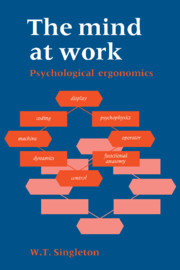Crossref Citations
This Book has been
cited by the following publications. This list is generated based on data provided by Crossref.
Kaplan, Michael
1991.
Automation and Systems Issues in Air Traffic Control.
p.
381.
STANTON, N. A.
BOOTH, R. T.
and
STAMMERS, R. B.
1992.
Alarms in human supervisory control: a human factors perspective.
International Journal of Computer Integrated Manufacturing,
Vol. 5,
Issue. 2,
p.
81.
Blum, LL
1992.
Operating Room and Intensive Care Alarms and Information Transfer.
p.
32.
Hollywell, P
and
Marshall, E
1994.
Human Factors in Alarm Design.
p.
31.
Stanton, Neville
1994.
Human Factors in Alarm Design.
p.
93.
BABER, C.
and
STANTON, N. A.
1994.
Task analysis for error identification: a methodology for designing error-tolerant consumer products.
Ergonomics,
Vol. 37,
Issue. 11,
p.
1923.
PAGE, M. R. H.
1995.
Human factors: a user's view of ergonomics.
Ergonomics,
Vol. 38,
Issue. 3,
p.
539.
STANTON, NEVILLE A.
and
BABER, CHRISTOPHER
1995.
Alarm-initiated activities: an analysis of alarm handlingby operators using text-based alarm systems in supervisory control systems.
Ergonomics,
Vol. 38,
Issue. 11,
p.
2414.
KAPLAN, MICHAEL
1995.
The culture at work: cultural ergonomics.
Ergonomics,
Vol. 38,
Issue. 3,
p.
606.
HANCOCK, P. A.
1996.
Effects of control order, augmented feedback, input device and practice on tracking performance and perceived workload.
Ergonomics,
Vol. 39,
Issue. 9,
p.
1146.
Paul, Rajendra
1996.
Understanding Individual Learning for Organizational Learning.
Proceedings of the Human Factors and Ergonomics Society Annual Meeting,
Vol. 40,
Issue. 15,
p.
791.
Stanton, N
and
Marsden, P
1997.
Drive-by-wire systems: Some reflections on the trend to automate the driver role.
Proceedings of the Institution of Mechanical Engineers, Part D: Journal of Automobile Engineering,
Vol. 211,
Issue. 4,
p.
267.
Young, Mark S.
and
Stanton, Neville A.
2002.
Attention and automation: New perspectives on mental underload and performance.
Theoretical Issues in Ergonomics Science,
Vol. 3,
Issue. 2,
p.
178.
Young, Mark S.
and
Stanton, Neville A.
2002.
Malleable Attentional Resources Theory: A New Explanation for the Effects of Mental Underload on Performance.
Human Factors: The Journal of the Human Factors and Ergonomics Society,
Vol. 44,
Issue. 3,
p.
365.
Marsden, Philip
and
Kirby, Mark
2004.
Handbook of Human Factors and Ergonomics Methods.
p.
34-1.
Young, Mark
and
Stanton, Neville
2004.
Handbook of Human Factors and Ergonomics Methods.
p.
39-1.
Stanton, N. A.
Stewart, R.
Harris, D.
Houghton, R. J.
Baber, C.
McMaster, R.
Salmon, P.
Hoyle, G.
Walker, G.
Young, M. S.
Linsell, M.
Dymott, R.
and
Green, D.
2006.
Distributed situation awareness in dynamic systems: theoretical development and application of an ergonomics methodology.
Ergonomics,
Vol. 49,
Issue. 12-13,
p.
1288.
Young, Mark S.
Robinson, Stephanie
and
Alberts, Phil
2009.
Students pay attention!.
Active Learning in Higher Education,
Vol. 10,
Issue. 1,
p.
41.
Funke, Gregory J.
Knott, Benjamin A.
Salas, Eduardo
Pavlas, Davin
and
Strang, Adam J.
2012.
Conceptualization and Measurement of Team Workload.
Human Factors: The Journal of the Human Factors and Ergonomics Society,
Vol. 54,
Issue. 1,
p.
36.
Sorensen, L.J.
and
Stanton, N.A.
2013.
Y is best: How Distributed Situational Awareness is mediated by organisational structure and correlated with task success.
Safety Science,
Vol. 56,
Issue. ,
p.
72.



